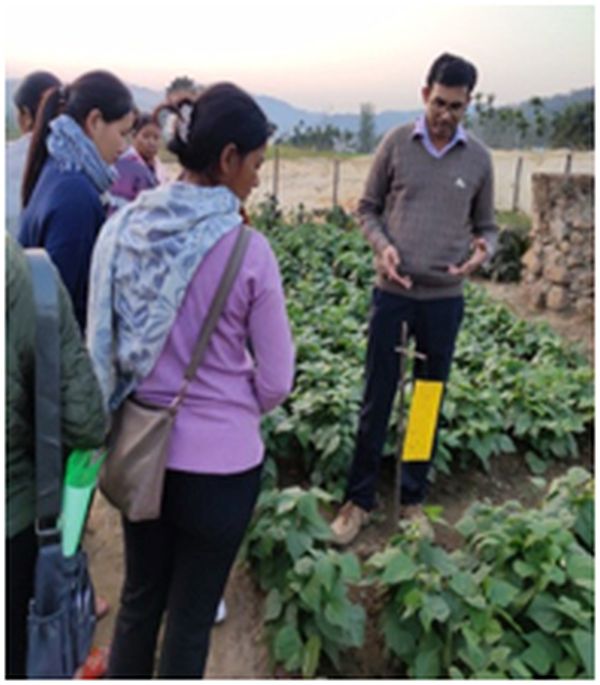
Harendra Verma, Rajesha G., Christy Sangma & D. J. Rajkhowa
ICAR Nagaland Centre, Jharnapani, Medziphema, Nagaland 797106
Importance: Agronomic management is the most important way to realize the potential yield and net returns in any crop. It increases the stability of farm productivity over years by improving natural resource management and crop management system. Majority of farmers’ cultivate French bean without maintaining any plant geometry. Adoption of proper spacing both row to row and plant to plant has several advantages like, maintenance of optimum plant population, fertilizer application, facilitate intercultural operations as well as in realizing quality produce. Low plant density leads to high growth of weeds and less realization of harvestable produce whereas overcrowding among plants enhances intra-crop competition for various growth factors, thereby reduces yield and quality of produce. Proper spacing and optimum plant stand also helps in maintaining appropriate micro-climate which lead to enhance growth and productivity. Fertilization is mainly limited to use of nitrogenous fertilizers which results in imbalance of nutrients in soil. Therefore, balance application of nutrients is required for maintaining soil health in sustainable way. During critical stages of crops availability of optimum moisture is required for nutrient availability and uptake as well as other plant metabolic activities. As such, timely irrigation is crucial for enhanced growth and development of plants and realizing the quality of harvestable produce. Timely management of weeds from crops field is also essential as weeds compete with the crop for various growth factors, encourages pests incidence and reduces the quality of the produce. Furthermore, weed act as alternate hosts for many harmful insects and pathogens. There are many options available for economic and efficient weed control. Integrating different methods like manual, mechanical, cultural and also chemical ensures sustainable weed management. Comprehensive options for good agronomic practices have been described below. For further information, ICAR, Nagaland centre, Medziphema may be contacted.
Soil: A well drained loamy soil having a pH range of 5.5-6.0 with moderate to cool climate is suitable for French bean cultivation.
Land preparation: The crop requires a moderate soil tilth for better seed germination and early crop growth. The land should be ploughed/hoed 2- 3 times for breaking the clod, removing the weeds as well as to create a suitable soil environment. There should be provision to drain out excess moisture from the field as the crop can not tolerate water logging conditions.
Sowing time and spacing: There is wider window of sowing for French bean. Depending upon the temperature and moisture regimes, the crop is sown during different seasons. In hilly area, February-March and October-November are the suitable time for sowing. In plains October-November is the suitable time for sowing. The seed should be sown in lines maintaining a row to row and plant to plant spacing of 30 x 15 cm.
Seed rate: A seed rate of 80 kg/ha for bush type and 50 – 55 kg/ha for poll type varieties is optimum.
Seed treatment: Seeds are to be treated with Trichoderma 4 g/kg or Thiram or Carbandazim @ 2 g/kg of seed for 24 hours before sowing to control fungal diseases. Rhizobium inoculation @ 15 g/kg of seeds is highly beneficial for nutrient economization improving productivity.
Irrigation: Optimum soil moisture gives dividends to the farmers. As such, depending upon the soil moisture availability, irrigation is to be done immediately after sowing for better germination and initial crop establishment. Further, need based irrigation may be given at critical stages of crop growth viz., flowering and pod formation to realize higher productivity.
Weed management: First weeding should be carried out in between 20 - 25 days after sowing and second weeding in between 40 - 45 days after sowing. The crop should be earthed up after each weeding to avoid lodging.
Integrated nutrient management: Integrated nutrient management maintains soil health and farm productivity. Apply 5 tonnes of FYM per hectare in soil one month before sowing and to get higher productivity apply Nitrogen, Phosphorus and Potash 50:75:75 kg/ha as basal dose and apply 25 kg N/hectare 30 days after sowing. Treat the seeds with rhizobium + PSB (phosphorus solubilizing bacteria) at the rate of 15 gm/ kg seeds.
Diseases of French bean: French bean is generally free from major insect damage. Anthracnose, rust and bean mosaic virus are the major diseases. These diseases can cause serious yield losses to the tune of 30-40 %.
Anthracnose symptoms: Small reddish-brown, slightly-sunken spots form on the pods and rapidly develop into large, dark-sunken lesions. In moist weather, masses of pink spores develop on these lesions. Black-sunken spots, similar to those on the pods, are produced on the stems. Infection of the leaves causes blackening along the veins, particularly on the undersurface.
Rust symptoms: Bean rust is a fungal disease affecting leaves, pods and stems of French beans. This disease can reduce yields up to 30%. The symptoms are rust-coloured spots with yellow halo. The spots first appear as small brown dots containing a brown powder. Later, spots become larger and spores turn black.
Integrated disease management: Integrated disease management reduces the use of fungicides and is environmentally safe. Farmers are advised to use certified and disease free seed. Seed treatment with trichoderma 4gm/kg seeds is useful to avoid the incidence of disease during seedling establishment. Do not plant beans for at least two years in land that has carried an infected crop. Follow crop rotation with non host crops. Continuously monitor the field and remove diseased plants or diseased leaves and bury them to reduce the further spread of disease and the over-season survival of the pathogen. However, do not walk through your field during wet weather otherwise it leads to spread of disease. Do not pack diseased pods as anthracnose can develop during transport. If the severity of disease incidence is high then farmers are advised to use less harmful fungicides such as alternate spray of mancozeb and bavistin at the rate of 2gm/ml of water.
Farmers may use copper oxychloride, or tebuconazol at the rate of 1gm/liter of water for management of rust, but these fungicides are toxic to consumers. Always wear protective clothing during sprays. Spray maximally twice per season, and stop spraying 35 days before harvest. Nobody should enter sprayed fields during 3 days. If disease symptoms are found on most of the bean plants, spraying is too late.

Insect pest of French bean and their management
Aphids and thrips: Spray Neem oil 2ml/liter of water or Methyl demeton 25 EC or Dimethoate 30 EC each at 1 ml/lit.
Whitefly: Place 20 yellow sticky traps coated with castor oil per hectre to attract the white flies.
Yield
15 tonnes/ha of green pods and 2.5 - 3.0 t/ha of seeds.




